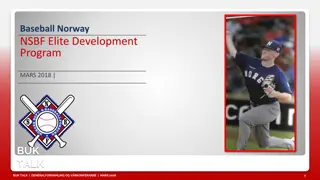Exploring Pitcher's ERA and Strikeout Relationship in Baseball
An analysis was conducted to investigate the relationship between a Major League pitcher's Earned Run Average (ERA) and the number of strikeouts during the 2018 regular season. Using a simple random sample of 30 pitchers, a correlation coefficient of -0.376 was found, indicating a moderately weak negative relationship between ERA and strikeouts. The scatterplot, Pearson's correlation coefficient, and coefficient of determination were used to further analyze the data, revealing insights on how a pitcher's ERA may impact their strikeout performance.
Download Presentation

Please find below an Image/Link to download the presentation.
The content on the website is provided AS IS for your information and personal use only. It may not be sold, licensed, or shared on other websites without obtaining consent from the author. Download presentation by click this link. If you encounter any issues during the download, it is possible that the publisher has removed the file from their server.
E N D
Presentation Transcript
Is there a relationship between a pitcher s Earned Run Average (ERA) and the number of strikeouts? Sample Presentation Mr. Linden
Population Population includes all major league pitchers from the 2018 baseball regular season. Pitchers needed to pitch at least 50 innings to be included in the list. The population includes both starting pitchers and relievers. My sample consisted of 30 pitchers.
Description of Data Independent Variable is a pitcher s Earned Run Average (ERA). Earned run average is calculated by dividing the number of earned runs allowed by the number of innings pitched and multiplying by nine. This is a Numerical Continuous statistic. Dependent Variable is a pitchers number of Strikeouts. This is a Numerical Discrete statistic.
Sampling Technique I used a Simple Random Sample technique to collect my data. I went to MLB.com and selected Stats. I made sure to use the 2018 regular season. I selected pitchers only and selected pitching statistics. I sorted the statistics based on IP and organized the list from greatest to least. I used a random number generator to create a sequence of 30 numbers. I used those numbers to record each players name, team, ERA, and strikeouts.
Data Table Collected May, 16, 2019
Pearsons Correlation Coefficient R The correlation coefficient for the data: R = -0.376 This indicates that there is a moderately weak, relationship between a player s ERA and number of strikeouts. The relationship is negative, which makes sense, for the study. The lower the pitcher s ERA is the more strike outs he has thrown.
Line of Fit & Coefficient of Determination Coefficient of Determination The Line of Best Fit: This indicates that only 14% of the variation in the data can be explained by the line of fit. The y-intercept relates to the number of strikeouts This would not be a good model to predict future behaviors.
Descriptive Statistics Earned Run Average (ERA) 3.917 Strikeouts Mean 90 St. Deviation 1.11197 41.40129 Confidence Interval 3.519 < mu < 4.315 75.185 < mu < 104.815
Conclusion In conclusion there does not seem to be a very good relationship between a pitcher s ERA and the number of strike outs. On average a pitcher has an approximately 3.91 ERA with around 90 strikeouts.






















